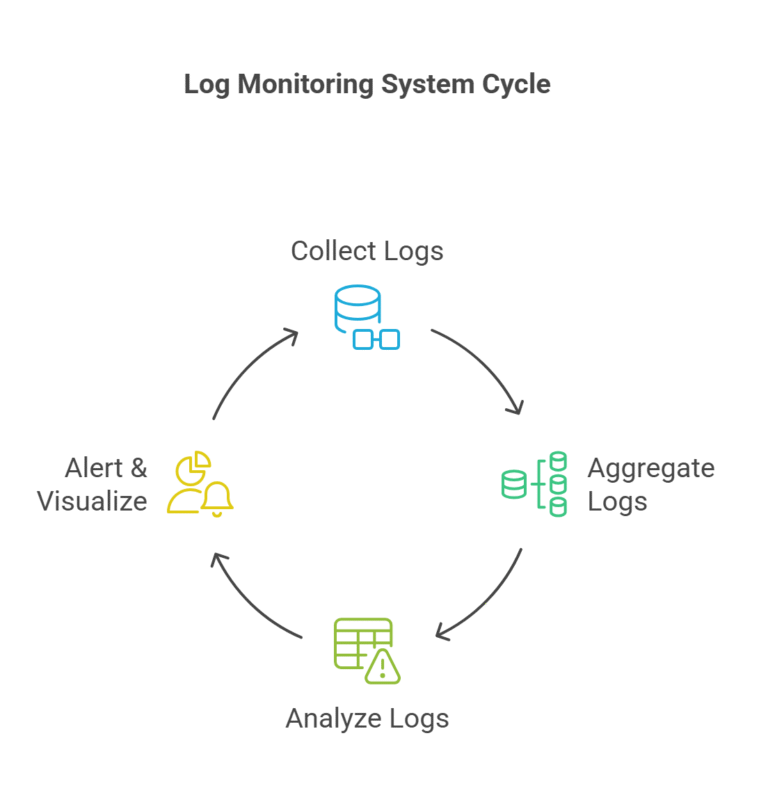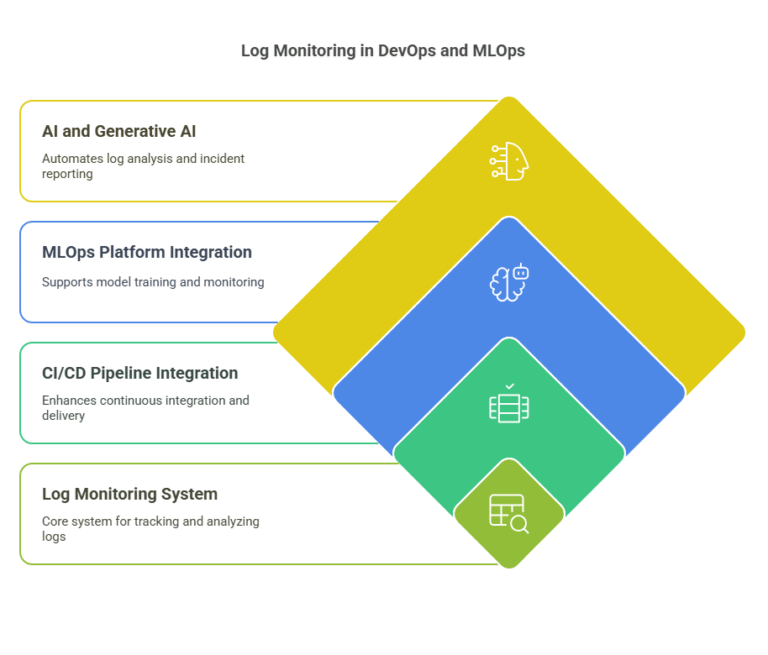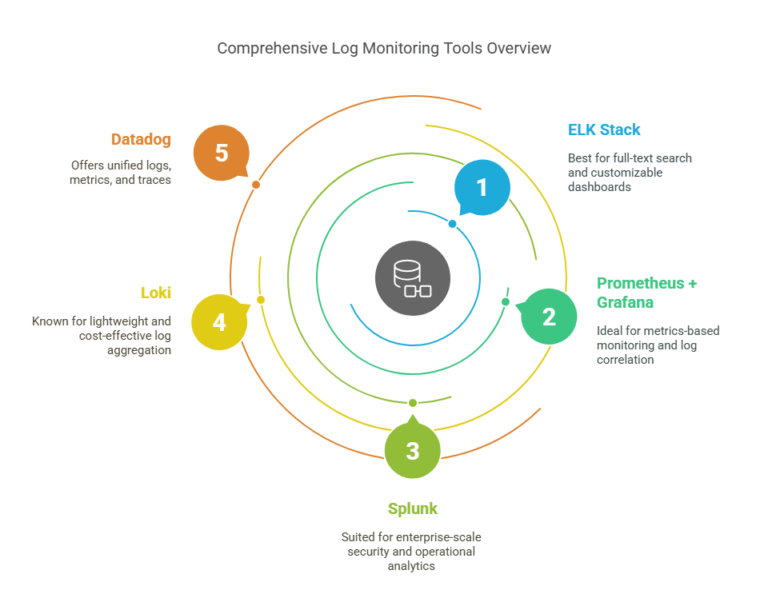From Logs to Insights: How Log Monitoring Boosts System Reliability
Introduction
In the digital world today, reliability is essential, timeliness is required. A reliable log monitoring system is an important part of of reliable applications, timely discovery of your security risks and proactive performance effort.
This guide investigates the way log monitoring systems provide system reliability, connect with DevOps systems, and interact with security monitoring systems to provide end to end observability. We will noted the way they are used in pipelines in DevOps, MLOps platforms, and devops genai i, and how DevSecOps.ai can add value to your monitoring with AI.

What is a Log Monitoring System?
A log monitoring system collects, analyzes, and visualizes log data from applications, servers, and infrastructure. It helps teams:
✔ Detect anomalies in real-time
✔ Troubleshoot issues faster
✔ Improve security by identifying threats
✔ Optimize performance with data-driven insights
Key Components of Log Monitoring
- Log Collection (Fluentd, Filebeat)
- Log Aggregation (ELK Stack, Loki)
- Log Analysis (Splunk, Datadog)
- Alerting & Visualization (Grafana, Kibana)
Why Log Monitoring is Essential for System Reliability
1. Proactive Issue Detection & Resolution
- Real-time alerts on errors and performance degradation
- Root cause analysis using correlated logs
- Reduced MTTR (Mean Time to Resolution) with structured log queries
2. Enhanced Security with a Security Monitoring System
Log monitoring integrates with security monitoring systems to:
✅ Detect intrusion attempts (SIEM tools like Splunk, Wazuh)
✅ Identify unauthorized access (audit logs)
✅ Comply with regulations (GDPR, SOC 2)
3. Performance Optimization
- Track latency, errors, and throughput
- Identify resource-heavy processes
- Optimize database queries and API calls

Log Monitoring in DevOps Technologies
1. Logs Monitoring in DevOps Pipeline
A well-integrated log monitoring system enhances CI/CD pipelines by:
🔹 Tracking build failures (Jenkins, GitHub Actions logs)
🔹 Monitoring deployment health (Kubernetes logs via ArgoCD)
🔹 Ensuring compliance ( audit logs for change tracking)
Example:
- Failed CI job → Logs reveal a dependency conflict → Fix applied before production deployment
2. Integration with MLOps Platforms
MLOps platforms rely on logs for:
✔ Model training monitoring (GPU usage, errors)
✔ Inference latency tracking (API response times)
✔ Data drift detection (Anomalies in input data)
Tools:
- MLflow (Experiment tracking)
- Weights & Biases (Model performance logs)
3. AI and Generative AI in DevOps for Smarter Log Analysis
Generative AI in DevOps transforms log monitoring by:
🔸 Automating log parsing (Natural Language Processing)
🔸 Predicting failures (Machine Learning models)
🔸 Generating incident reports (AI-powered summaries)
Example:
- GenAI tool analyzes error logs → Suggests fixes based on past incidents → Reduces manual debugging time

Top Log Monitoring Tools & Technologies
1. ELK Stack (Elasticsearch, Logstash, Kibana)
- Best for: Full-text search, customizable dashboards
- Use Case: Centralized logging for microservices
2. Prometheus + Grafana
- Best for: Metrics-based monitoring with log correlation
- Use Case: Kubernetes cluster monitoring
3. Splunk
- Best for: Enterprise-scale security and operational analytics
- Use Case: SIEM (Security Information and Event Management)
4. Loki (by Grafana Labs)
- Best for: Lightweight, cost-effective log aggregation
- Use Case: Cloud-native log monitoring
5. Datadog
- Best for: Unified logs, metrics, and traces
- Use Case: Full-stack observability
Best Practices for Effective Log Monitoring
1. Structured Logging (JSON, Key-Value Pairs)
- Ensures easier querying and filtering
- Example:
- json
- Copy
- { “timestamp”: “2024-05-20T12:00:00Z”, “level”: “ERROR”, “message”: “Database connection failed”, “service”: “payment-gateway” }
2. Centralized Log Aggregation
- Avoid siloed logs across servers
- Use Fluentd or Vector for log forwarding
3. Real-Time Alerting
- Set up threshold-based alerts (e.g., PagerDuty, Opsgenie)
- Example:
- Alert Condition: ERROR logs > 10 in 5 minutes
- Action: Notify DevOps team via Slack
4. Retention & Archiving Policies
- Hot storage (30 days for active analysis)
- Cold storage (S3/Glacier for compliance)
5. Security & Compliance
- Mask sensitive data (PII, passwords)
- Encrypt logs in transit and at rest
The Future: AI-Driven Log Monitoring with DevSecCops.ai
As systems grow more complex, traditional log monitoring alone isn’t enough. AI-powered log analysis is the future, enabling:
🔹 Anomaly detection (Unsupervised ML models)
🔹 Automated incident classification (NLP-based tagging)
🔹 Predictive maintenance (Forecasting failures)
DevSecCops.ai integrates AI-driven log monitoring with security and DevOps pipelines, providing:
✅ Automated threat detection
✅ Smart log correlation
✅ GenAI-powered troubleshooting

Conclusion: Transforming Logs into Actionable Insights
A log monitoring system is no longer optional—it’s a core pillar of system reliability. By integrating with DevOps technologies, security monitoring systems, and MLOps platforms, organizations gain end-to-end observability.
With advancements in generative AI in Devops, log analysis is becoming smarter, faster, and more automated. Tools like DevSecCops.ai further enhance this by combining AI-driven insights with security and compliance monitoring.
Key Takeaways
Log monitoring prevents downtime by detecting issues early
Security logs are critical for threat detection
AI & GenAI are revolutionizing log analysis
DevSecCops.ai bridges the gap between logs, security, and automation
Embrace intelligent log monitoring today to build more reliable, secure, and high-performing systems!
